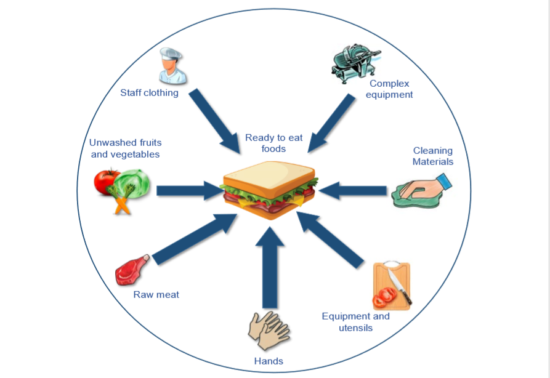Cross-contamination is the transfer of harmful microorganisms or substances to food or other surfaces through direct or indirect contact. This transfer can occur from raw food to ready-to-eat food, from hands to food, from equipment to food, or from food to food. Cross-contamination can lead to foodborne illnesses if the contaminated food is consumed without proper cooking or sanitation.
Preventing cross-contamination is crucial in maintaining food safety. This can be achieved by following proper food handling practices such as separating raw foods from ready-to-eat foods, using different cutting boards for raw meat and produce, washing hands and surfaces frequently, and ensuring that cooking equipment is cleaned and sanitized regularly.
Cross-contamination guidelines:
Cross-contamination is the transfer of harmful microorganisms or substances to food and surfaces. To prevent cross-contamination, especially in food handling and preparation, specific procedures need to be followed. Here are some general guidelines for preventing cross-contamination:
1. **Separate Raw and Cooked Foods**: Keep raw meats, poultry, seafood, and eggs separate from ready-to-eat foods during storage and preparation. Use separate cutting boards, utensils, and plates for raw and cooked foods.
2. **Clean and Sanitize**: Wash hands thoroughly with soap and water before and after handling food, especially after handling raw meat, poultry, or seafood. Clean and sanitize countertops, cutting boards, utensils, and other surfaces that come into contact with food.
3. **Store Food Properly**: Keep raw foods below ready-to-eat foods in the refrigerator to prevent drips or leaks from raw food contaminating cooked food. Store foods in sealed containers to prevent cross-contamination.
4. **Use Color-coded Utensils**: In commercial kitchens, using color-coded utensils can help prevent cross-contamination. For example, using red cutting boards and utensils for raw meat and green for fruits and vegetables.
5. **Cook Food Thoroughly**: Cooking food to the proper internal temperature can kill harmful bacteria and reduce the risk of foodborne illness.
6. **Be Mindful of Allergens**: If preparing food for someone with food allergies, take extra precautions to prevent cross-contact with allergens. Use separate utensils, cutting boards, and preparation areas to avoid cross-contamination.
7. **Train Staff**: In a commercial setting, ensure all staff members are trained in proper food handling procedures to prevent cross-contamination.
By following these procedures and being mindful of food safety practices, you can reduce the risk of cross-contamination and ensure the safety of the food you prepare and serve.
To all my friends, who love cooking. Here is an interesting cross-contamination cleaning product.

Disclaimer:
This post contains affiliate links which means I may receive a small commission if you purchase using that link at no extra cost to you. and if you do,
I appreciate you!




